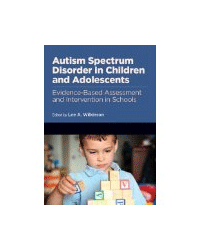Autism Spectrum Disorder in Children and Adolescents: Evidence-Based Assessment and Intervention in Schools

“Autism Spectrum Disorder in Children and Adolescents: Evidence-Based Assessment and Intervention in Schools”
Edited by Lee A. Wilkinson
American Psychological Association
Washington, D.C., 2014
School practitioners could benefit from ASD-themed book
Reviewed by James K. Luiselli, Ed.D., ABPP, BCBA-D
Current statistics estimate that one in every 88 school-age children and youth has been diagnosed with autism spectrum disorder (ASD).
This population size has produced a corresponding increase in the number of students with ASD attending public schools. Psychologist Lee A. Wilkinson concludes correctly that “Providing effective behavioral supports and interventions to the ever-increasing numbers of children with ASD presents a major challenge to the educational communities that serve them.”
The overriding theme of this book is that school practitioners should be informed about the most contemporary evidence-based methods for assessment and intervention in ASD.
Wilkinson first orients the reader to the evolution of evidence-based practice by referencing guidelines promulgated by the American Psychological Association, the Task Force on Evidence-Based Interventions in School Psychology, and several ASD specialty organizations.
This information is a useful backdrop for readers who are less familiar with evidence-based standards and the impact they have had on educating and treating children and youth with ASD.
The book contains 11 chapters written by notable experts in the ASD field. There are six chapters devoted to assessment, starting with a concise overview of ASD prevalence, core features, and the newest diagnostic criteria outlined in the Diagnostic and Statistical Manual of Mental Disorders-5th Edition.
Other areas of assessment concentration covered in the book include developmental screening, cognitive-neurological testing and evaluating communication ability, social skills and co-occurring conditions.
These chapters adequately represent and explain the respective “gold standard” assessment instruments and the critical steps that comprise diagnostic formulation.
The five chapters devoted to intervention are wide-ranging. The more technically-focused chapters address curriculum design and classroom strategies founded principally in applied behavior analysis.
Several process-centered chapters discuss a continuum of services model and collaborative team-building between schools and families. Readers will also enjoy the concluding chapter which deals with legal issues that arise for children and youth with ASD under the Individuals with Disabilities Act (IDEA, 2011).
Wilkinson targeted his book to educational and school psychologists, administrators, counselors, social workers and graduate students.
Each chapter is relatively brief but detailed enough to direct readers toward best practices. Although not intended as a practitioner’s guide, the book has a pragmatic feel to it – as such, there are many suggestions for building and improving ASD service delivery in schools.
The information contained in the book will also stimulate new thinking about practitioner training needs to further advance exemplary school programs.
As with any edited book, not every topic of interest can be included. For example, future editions of the book might consider medical problems of children and youth with ASD attending schools, the ever-increasing role of alternative and augmentative communication, and bullying prevention of students with special needs.
In its current form, Wilkinson has fashioned a very good book for ASD school practitioners, with commendable interdisciplinary appeal and a much needed dose of empiricism!
James K. Luiselli, Ed.D., ABPP, BCBA-D, is Chief Clinical Officer, Clinical Solutions, Inc. and North East Educational and Developmental Support Center, Tewksbury, Mass..
Learn more about the book: Autism Spectrum Disorder in Children and Adolescents: Evidence-Based Assessment and Intervention in Schools (School Psychology) (School Psychology Book Series)
